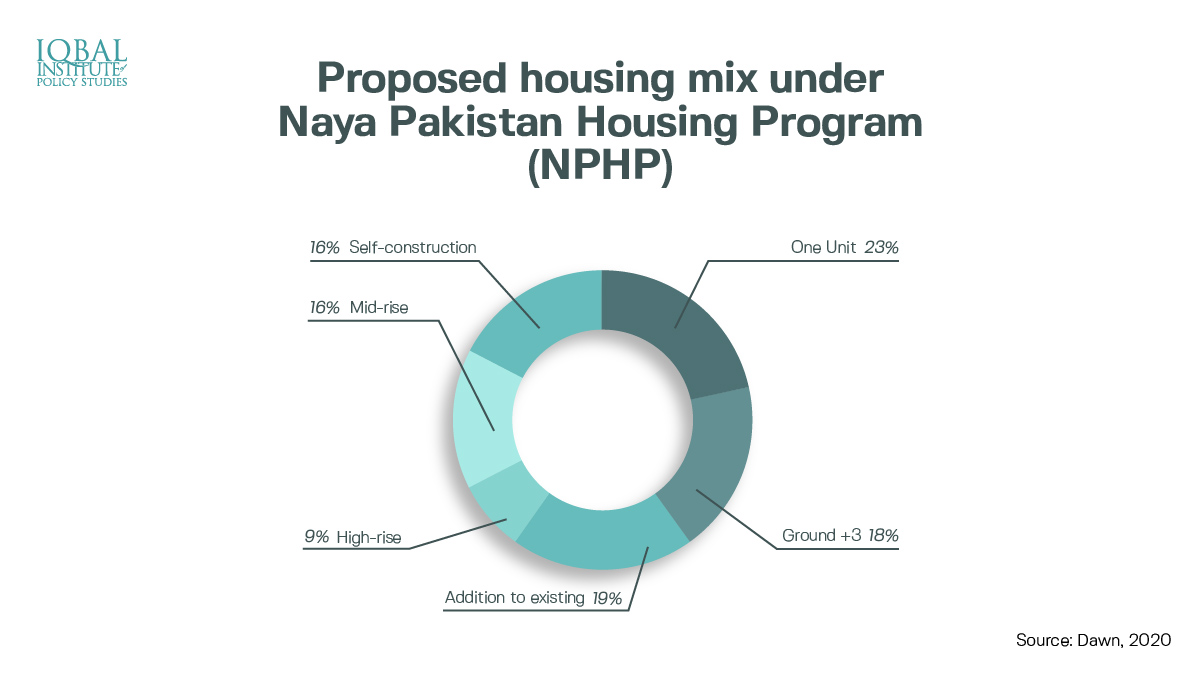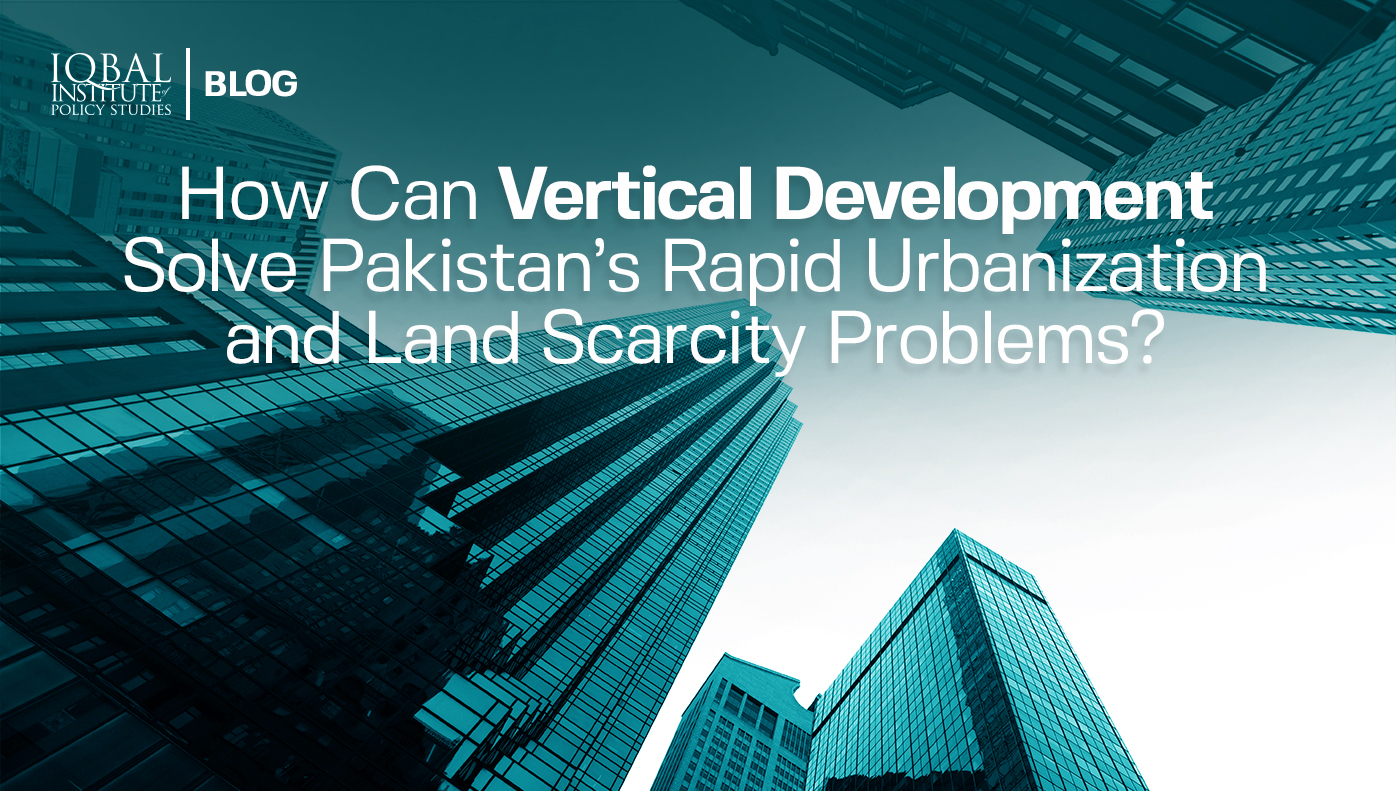Preamble
Vertical growth of cities is an important step towards creating smart cities. Vertical development can help modern cities solve some of the deepest and most problematic issues like traffic, land scarcity, and uncontrolled urban sprawl. If cities were to develop vertically, they would become sustainable in terms of energy, space, and overall efficiency.
This blog elaborates on how Pakistan can adopt the vertical development model in its urban areas to prevent rapid urbanization and land scarcity issues.
Research Questions
- How will Vertical development lead to smarter cities?
- How vertical housing affects the standard of living in Pakistan?
- What are the challenges Pakistan is facing toward Vertical development?
- How vertical housing is the future of Pakistan’s housing development?
Introduction
The need for vertical development can be highlighted by the real estate and urban crises stemming from the scarcity of land and the need to halt rapid urbanization. The lack of affordable housing for millions of people, worldwide and in Pakistan, shows how much vertical development of cities and urban areas is central to solving these issues. With a 10.3 million housing backlog in Pakistan, there is a need for a sustainable urban development model for its resolve (State bank of Pakistan, 2018). One of these models is the vertical development model, supported by the Government of Pakistan, urban planners, and the State Bank of Pakistan, to solve the urban housing crisis of Pakistan. The State Bank’s finance policy for low-cost housing in the capital has received a mix-response. The Government of Pakistan is focused on providing vertical housing options to the citizens, which calls into question the impact of vertical housing and the possibility of it serving the needs of the country’s housing backlog, its alarming urbanisation rate, population growth and economic crisis.
How Vertical Development will Lead to Smarter and Better Cities
Vertical development is the growth of cities in the upward direction as human habitat shifts to massive skyscrapers. Vertical cities promote sustainable development as they aim to control the horizontal spread of the population. The expansion of cities and urban areas is the most detrimental aspect of urbanisation on the environment. Many cities around the world have been expanded beyond control as forests and swamps have been destroyed to build houses, shopping centres, and factories. In vertical development, these areas are placed in vertical towers to preserve the environment. A city’s vertical development is part of the smart city ideal which aims to develop cities in ways that are sustainable environmentally, economically, and socially. Vertical cities and their development can be rendered smart if they use a set of systems that allow the development to be interconnected, in constant communication, and exchange information to make efficient decisions. Theoretically, such a city will be the single most highly efficient and sustainable model for urban development with a self-updating system (Savills, 2020). Smart cities and the concept of vertical development of the cities have been introduced to address the challenges and issues faced by traditional or conventional cities. Although the lack of energy efficiency and greenhouse gas emissions are some of the most important issues in urban areas, land scarcity, rapid urbanisation, and environmental degradation are also critical issues. Hence, vertical development of cities, through high-rise buildings and infrastructure, can accommodate major residential and commercial properties. (Tayyab, Ajibade, & Muhammad, 2017)
What are The Local and Global Challenges Facing Vertical Development?
Globally, vertical development is endorsed by different commercial and residential real estate developers for the purpose of creating sustainable urban developments which will not only use less land but serve multiple purposes. The idea of smart cities through vertical development is attractive, but the road to creating truly safe and practical vertical development has a lot of design and connectivity challenges. The design of residential areas, and commercial areas, along with vertical developments for agriculture, like the one created by Abu-Dhabi in the form of vertical farming models, shows that every vertical development and its design is drastically different from the purpose it serves (Willige, 2020).
Similarly, internal transportation would be a complex network of elevators based on rail-based systems like maglev and monorails. Communication, transportation, and logistics will be important determinants in measuring the success of vertically developed areas. There will be a number of amenities absent from vertically developed areas which are often taken for granted, such as open-air walks etc., which are common in traditional development areas. Vertical development will not just be a test for urban planners, but also for architects, civil engineers, policymakers, business experts, and environmental experts as well. If vertical development goes wrong, the consequences can be far worse in comparison to horizontal sprawl as this developmental model has not been sufficiently tried and tested in cities around the world. Hence, proper planning and strict implementation of building bye-laws are required to construct high-rise buildings and skyscrapers (Asim, Gulzar, & Shirwani, 2017).
Pakistan, as a third world country, is grossly underprepared for integrating tall, multi-storey, and multi-purpose buildings in its urban infrastructure. Pakistan has observed many unfortunate incidents which exposed the lack of endorsement of building bye-laws at a national scale. There is a lack of truly independent planning agencies with professional expertise in the country which can supervise the execution of their plans to ensure maximum public benefit. The seismic vulnerability of Pakistani infrastructure became evident in the 2005 earthquake and the subsequent collapse of Margalla towers, exposing the ill-planning and miscalculated engineering of the building design (DAWN, 2015). If vertical development is relentlessly pursued, it can be environmentally dangerous. Local and international urban experts agree on the fact that without proper planning and provision of adequate service amenities like electricity, sewerage, gas, and drinking water, vertical growth should not be initiated in an area to prevent the development of any building which cannot be sustained in the future.
How Vertical Development Affects The Standard of Living in Pakistan?
The government in Pakistan has taken steps toward banning real estate development projects on fertile agricultural lands and encouraged vertical instead of horizontal growth of cities. In addition to this, the government is encouraging vertical development by integrating high-rise construction in its signature development projects such as the Naya Pakistan Housing Program (NPHP). The primary motivation for introducing vertical development is to increase the standard of living for a majority of the population which is currently homeless. The vertical housing model is relatively cheaper when viewed in comparison to horizontally developed cities as that requires more space and has a much higher price label depending upon the location. Building bungalows limits the land for the use of only a few people as opposed to vertical housing which allows a limited piece of land to be used by many people for different purposes. Hence it has the ability to become an affordable housing model for the underprivileged and help developing countries in covering their housing crisis (Rashid, 2019).
A vertically developed infrastructure is environmentally sustainable as it has a reduced carbon footprint in comparison to horizontal expansion. The current government’s plan to introduce vertical development policies is also in-line with the ‘billion-tree tsunami’ project to reclaim forest areas in different parts of the country. With positive environmental benefits, vertical development has the ability to alleviate the standard of living for the country’s population as well as become an effective solution to increasing informal settlements (Al-Kodmany, 2018).
How Vertical Housing is The Future of Pakistan’s Housing Development?
There are different success stories in the area of vertical development which proves how vertical development of cities can solve multi-dimensional problems like uncontrolled urban dwellings and the housing crisis simultaneously. Singapore is a small Island nation with an area much less than what Pakistan has. The city experienced one of the highest rates of urban sprawl, until the national government decided to implement an action plan which resettled 2000 dwellings on 25,600-meter square space (Wong, 2004).
Considering all the strategic benefits of vertical development, the Government, under the State Bank of Pakistan (SBP) policy to promote low-cost housing, initiated the Naya Pakistan Housing Program (NPHP) to provide affordable housing for the poor. The program has been introduced to target the country’s 10 million housing deficit. However, the lower-income classes are not uniformly distributed with respect to their income and the area they are located in. This is why the NPHP aims to provide a mix of housing options for targeted people to create a more sustainable housing model. Depending upon the target population’s income level and the convenient form of housing construction, the housing mix has several options. The combination also includes the construction of mid-rise and high-rise construction, contributing to the cities’ vertical development (Khalil & Nadeem, 2019).
 Conclusion
Conclusion
Vertical development is observing a high endorsement rate as smart engineering technologies enable the creation of multi-storey buildings which can accommodate thousands of urban dwellers on a relatively small piece of land. Singapore’s successful experience with using the vertical development model for its infrastructure helped the country overcome its land scarcity and urban sprawl problem only in a span of a few years. Pakistan can also solve its multi-fold urban development problems by integrating this model in its urban infrastructure.
Key Takeaways
- The lack of affordable housing for millions of people worldwide and in Pakistan shows how much vertical development of the cities and the urban areas is central to solving these issues.
- Vertical development is the development of the cities in the vertical direction as human habitat develops upwards in massive skyscrapers.
- Vertical development of the cities, through high-rise buildings and infrastructure, can accommodate major residential and commercial properties.
- From transportation between the vertical infrastructures to the maintenance of temperature inside the building, are important challenges for the development of high-rise cities.
- Pakistan as a third world country is grossly underprepared for integrating tall, multi-storey and multi-purpose buildings in its urban infrastructure.
- Singapore experienced one of the highest rates of urban sprawl until the national government decided to implement an action plan which resettled 2000 dwellings on 25,600-meter square space.
References
Al-Kodmany, K. (2018). The Sustainable Vertical City Research Project. Chicago: University of Illinois, Chicago.
Asim, M., Gulzar, S., & Shirwani, R.,. (2017). Study on Impediments and Success of building Byelaws Implementation in Lahore, Pakistan. Journal of Architecture and Planning, 22(1).
DAWN. (2015, October 8th). Remembering Oct 8, 2005: The day the earth shook. From DAWN: https://www.dawn.com/news/1211695
Khalil, I., & Nadeem, U. (2019). Optimising the Naya Pakistan Housing Policy Opportunity. Tabadalab, Working paper 01.
Rashid, A. (2019, March 23rd). Will PTI’s housing programme address the root causes of the housing crisis? From Dawn: https://www.dawn.com/news/1439813
Savills. (2020). Singapore Industrial. Singapore: Savills Asian Cities Report.
State bank of Pakistan. (2018). The State of Pakistan’s economy: Third Quarterly Report. Pakistan: State bank of Pakistan.
Tayyab, A., Ajibade, A., & Muhammad, J.,. (2017). The Effects of High-rise Residential Construction on Sustainability of Housing Systems. Procedia Engineering, 1695-1704.
Willige, A. (2020, September 11). The UN says climate-smart cities are the future – these 3 projects show their potential. From the World Economic Forum: https://www.weforum.org/agenda/2020/09/climate-change-resilience-urban-infrastructure/
Wong, K. M. (2004). Vertical cities as a solution for land scarcity: the tallest public housing development in Singapore. URBAN DESIGN International, 17–30, 1.


Comments (2)
[…] amounts of raw material, efficient logistics, and advanced supply-chain management. Therefore, the impact of vertical development will be seen in increased consumption of raw material, installation and upgradation of […]
[…] amounts of raw material, efficient logistics, and advanced supply-chain management. Therefore, the impact of vertical development will be seen in increased consumption of raw material, installation and upgradation of […]